This article will give an overview of Mixed Method Research, its types, pros and cons of using mixed method.
Mixed method research is a methodological approach that combines different research methods to gain a more holistic understanding of a problem or issue. Mixed method techniques can be used to study human behavior, attitudes, and preferences, as well as social and environmental issues.
Mixed methods research can help researchers avoid the biases that are often associated with specific research methods. Mixed method research is also useful for generating new insights and knowledge about complex topics.
Mixed methods research is a hybrid approach to research that incorporates both qualitative and quantitative methods. Mixed methods research can provide more accurate and comprehensive data because it allows researchers to explore different aspects of a problem or issue from different angles.
Mixed methods research also allows researchers to better understand the participants’ perspectives and experiences.
What is Mixed Method?
Mixed methods research seeks to answer research issues that cannot be answered by “qualitative” or “quantitative” methods alone.
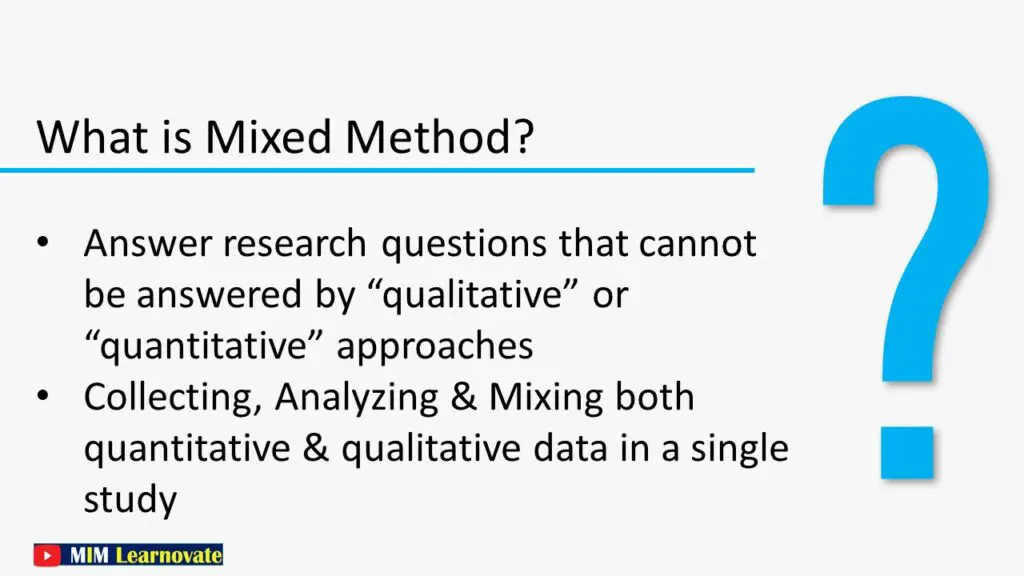
The goal of mixed methods research is to gather, analyze, and combine quantitative and qualitative data in a single study or series of studies.
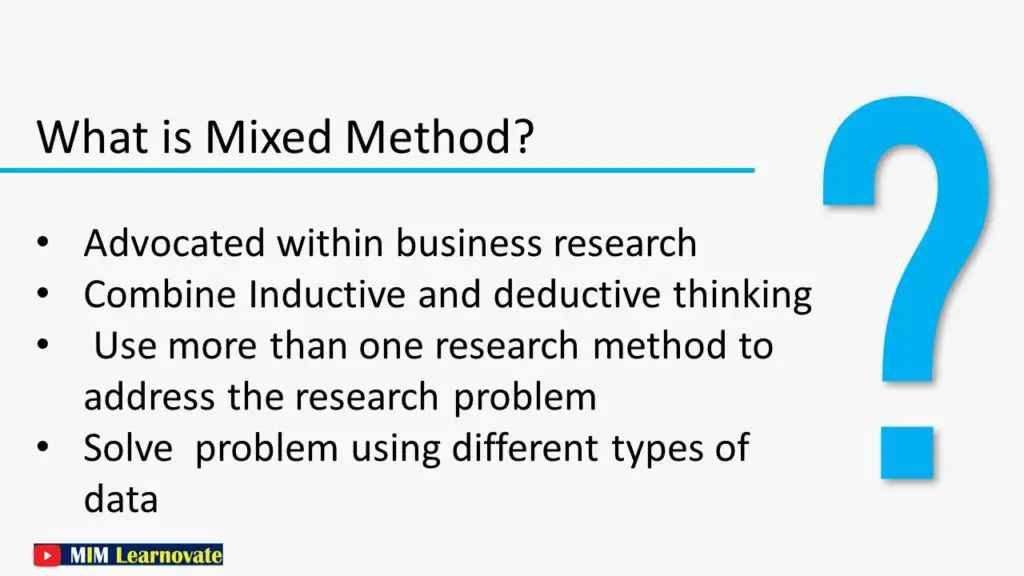
A mixed methodologies approach to business research is becoming more popular. This technique is appealing because it allows researchers to combine Inductive and deductive reasoning, using more than one research approach to handle the research problem and solving it with multiple types of data.
A mixed methods approach, on the other hand, complicates the study design and hence necessitates clear presentation to allow the reader to sort out its various components.
Example of Mixed Method
The company’s CEO interviewed managers to learn more about the nature of management work. Based on his interview data analysis, he developed theories on managerial roles, the nature and forms of managerial activities, and so on. These have been evaluated in a variety of situations, including interviews and questionnaire surveys.
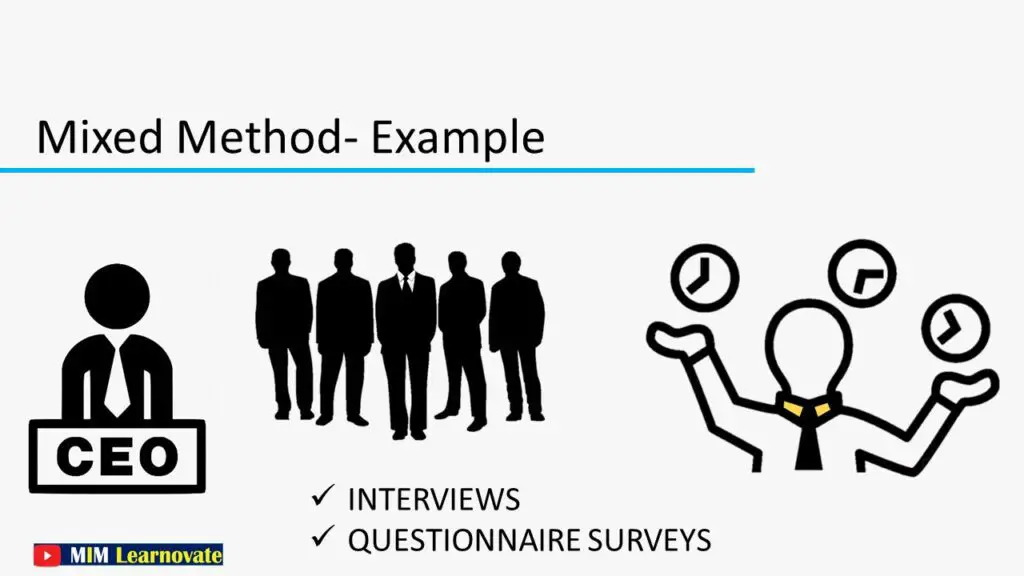
Types Mixed Method Design
Mixed methods research designs are classified into several sorts. The distinctions between them are related to the purpose of the research, the timing of data collection, and the weight given to each data type.
Convergent Parallel Design
In a convergent parallel design, quantitative and qualitative data are collected together and analyzed separately. When both analyses are finished, compare your results to reach broad conclusions.
Convergent design is employed when it is necessary to compare statistical data with qualitative findings in order to better comprehend the study challenge. This hybrid qualitative and quantitative research methods design is also used by researchers to validate and highlight qualitative findings with quantitative results.
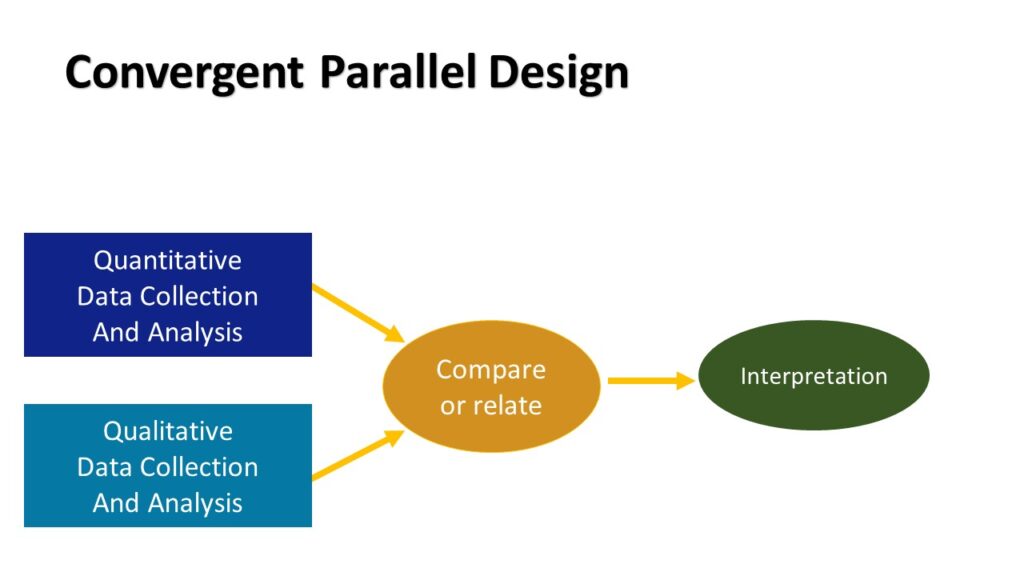
Embedded Design
If you are short on time or resources, this is a great method to adopt. An embedded design can be used to strengthen or supplement the primary type of research design’s conclusions.
In an embedded design, both forms of data are collected and analyzed at the same time, but within the context of a wider quantitative or qualitative design. One form of data is subordinate to another.
Exploratory Sequential Design
Qualitative data gathering and analysis come first in an exploratory sequential design, followed by quantitative data collection and analysis.
This design can be used to generate first questions and hypotheses. The quantitative data can then be used to test or verify your qualitative finding.
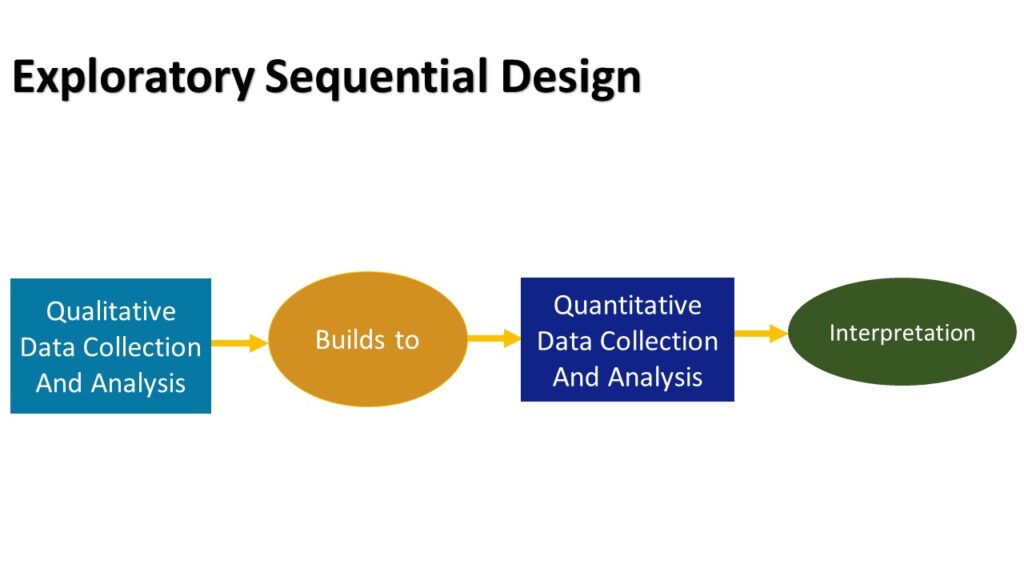
Explanatory Sequential Design
In an explanatory sequential design, quantitative data is collected and analysed first, then qualitative data is collected and analyzed.
This design should be used if you believe your qualitative data will explain and contextualize your quantitative findings.
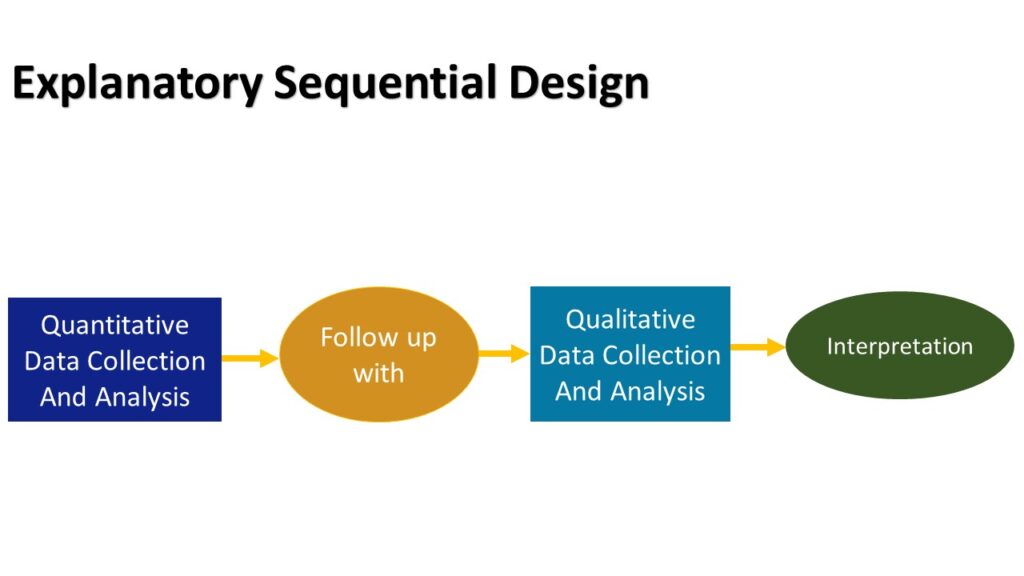
Research Questions in Mixed Method
Most researchers consider the research questions and/or hypotheses to be critical in determining the type of research approach to use. When both qualitative and quantitative data are needed to answer a question, a mixed method research design should be used.
Suppose a researcher conducted a study on the successful leadership strategies of Pakistani school principals. His research questions were as follows:
1. What types of leadership strategies do successful school principals in Pakistan employ?
2. Is there any overlap in the leadership styles of these schools’ principals?
3. Is there a difference in view about leadership methods between headteachers and their subordinates?
Researcher obviously wanted a broad profile, so his design included a survey with demographic, Likert-scaled, and open-ended questions; nevertheless, he also needed opinions, which are subjective and best handled by qualitative approaches.
Quantitative methods may be better suited to investigating frequency questions, whereas qualitative methods may be better suited to investigating perception and opinion.
Mixed techniques are likely to be preferred if the questions address both of these. It is also possible that the investigator wishes to delve deeper into a subset of a population, maybe following a larger survey.
Purpose of Conducting Mixed Method Research
There are five key reasons for performing mixed methods research:
Expansion
Expansion entails broadening the scope and scope of the research by employing diverse approaches for different lines of inquiry.
Triangulation
Triangulation is the process of confirming results using multiple approaches.
Initiation
the discovery of fresh insights that lead to the generation of new research questions.
Complementarity
Complementarity occurs when the results of one approach are utilized to enrich, elaborate, or clarify the conclusions of another method.
Pros of Mixed Method Research
1- The fundamental advantage of conducting mixed methods research is that you can use both qualitative and quantitative research approaches.
2- This method lets you to use the strength of one data type to compensate for the weakness of another.
3- Because mixed qualitative and quantitative research approaches are less bound by traditional research paradigms, they are more adaptable.
4- It enables to investigate a wide range of research problems. This is due to the fact that you are not restricted to a single study method.
5- This method assists researchers in gathering more evidence to support their findings.
6- It provides researchers with a comprehensive understanding of the topic or phenomenon under investigation.
Cons of Mixed Method Research
1- Mixed methods research necessitates the collection and analysis of two types of data, making it time-consuming and labor-intensive.
2- If the findings of two data formats in mixed method provide distinct outcomes, research can be difficult to comprehend.
3- Understanding numerous methodologies and how to combine them appropriately is required for mixed methods research.
Steps to conduct Mixed Method Research
There is no set procedure for performing a mixed-methods study. You can, however, perform mixed methods research by following the steps outlined below:
Determine whether mixed methods research is appropriate in your research.
The first stage is to decide whether mixed methods research will answer your research questions and provide the greatest type of evidence for your research topic.
Determine purpose of study.
Determine the purpose of study by employing a mixed methods study approach.
Is it to test, verify, develop, or supplement the results of one data type?
Choose the most suitable design.
Choose the best design from the four types of mixed methods research designs.
- Embedded Design
- Exploratory Sequential Design
- Explanatory Sequential Design
- Convergent Parallel Design
Gather qualitative and quantitative data.
Gather the qualitative and quantitative data that will be analyzed.
Data Analysis
Analyze the data you’ve gathered by using statistical tools.
Write research paper
After conducting data analysis you can validate, interpret, and write your research paper.
FAQs about Mixed Methods
How can you choose the right mixed methods research question?
When choosing the right mixed methods research question, it is important to consider the research question’s purpose and goals.
- The purpose of the study should be clear from the outset, and should guide both the selection of methods and analysis of data.
- Goals of the study should also be considered, as they will help determine what questions are most relevant to answering the research question.
Once a clear goal for the study is established, other factors to consider include whether or not a single method or set of methods will provide enough information to answer the question. If more than one approach is needed, it is important to select which one will provide the most reliable data.
Additionally, it is important to choose a method that will allow for an accurate assessment of participant’s experiences and opinions.
After selecting a method, it is necessary to develop a research design that will allow for collection of useful data.
How do you ensure that your findings from a mixed methods study are generalizable?
The goal of any research study is to generate valid and reliable findings that can be applied to the general population.
To do this, it is important to ensure that the findings from a mixed methods study are generalizable.
There are a number of ways to do this, but some key considerations include:
- Ensuring that the study design is appropriate for the research question being asked.
- Ensuring that the data collection procedures are standardized and fair.
- Considering whether the findings from the study can be generalized to other contexts or populations.
- It is also important to consider how specific factors, such as participant characteristics or researcher biases, might have influenced the results of a mixed methods study.
Ultimately, following these steps will help ensure that the findings from a mixed methods study are useful and applicable in multiple contexts.
How can you report the results of a mixed methods study effectively and efficiently?
When conducting a mixed methods study, it is important to be clear about the goals of each study component and how they will impact the overall results.
The following tips can help you report the results of your study effectively and efficiently:
1. Clearly outline the goals of each study component. This will help ensure that data from each component is used appropriately and that conclusions reached are consistent with the overall purpose of the study.
2. Label all data accurately. Tag all interview transcripts, observation logs, and survey responses with appropriate labels so that analysts can easily track information throughout the research process.
3. Make sure all data is properly archived. Researchers must always keep track of their data in order to reproduce findings or build upon previous work. Archiving data allows for future use in analysis, as well as provides evidence for academic publications or other presentations about the research project.
How do you deal with bias when conducting a mixed methods study?
When conducting a mixed methods study, it is important to be aware of the potential for bias.
There are a few ways to deal with bias in a study:
- First, try to ensure that all participants are treated equally.
- Second, try to use a variety of methodological strategies (e.g., qualitative and quantitative methods)
- Third, try to collect data from as many participants as possible.
There are a few things you can do to help reduce the chances of bias creeping into your research.
Before starting any study, be sure to discuss with your team what measures you will take to avoid bias.
Once you have started your study, it is important to keep track of how biased you are feeling and how this might be affecting the data collection and analysis.
Be honest with yourself and others about how you are behaving; if something is interfering with our ability to be unbiased, we need to address it.
Finally, once you have completed your study, make sure to share it with all the people who were involved in its production. This will help them understand how bias may have affected the results and help them develop ways to avoid it in their own work.
Conclusion
Mixed Methods research is a type of research that uses multiple methods to gather data. This approach can help researchers identify hidden patterns and insights that would not be apparent from just one method. Mixed Methods research can be helpful when studying complex topics or when data from different sources is needed. Additionally, using multiple methods can increase the reliability of the research findings. This article have given an overview of Mixed Method Research, its types, pros and cons of using mixed method.
Other articles
Please read through some of our other articles with examples and explanations if you’d like to learn more about research methodology.
Statistics
Methodology
- Research Methods
- Quantitative Research
- Qualitative Research
- Case Study Research
- Survey Research
- Conclusive Research
- Descriptive Research
- Cross-Sectional Research
- Theoretical Framework
- Conceptual Framework
- Triangulation
- Grounded Theory
- Quasi-Experimental Design
- Mixed Method
- Correlational Research
- Randomized Controlled Trial
- Stratified Sampling
- Ethnography
- Ghost Authorship
- Secondary Data Collection
- Primary Data Collection
- Ex-Post-Facto
Research
- Table of Contents
- Dissertation Topic
- Synopsis
- Thesis Statement
- Research Proposal
- Research Questions
- Research Problem
- Research Gap
- Types of Research Gaps
- Variables
- Operationalization of Variables
- Literature Review
- Research Hypothesis
- Questionnaire
- Abstract
- Validity
- Reliability
- Measurement of Scale
- Sampling Techniques
- Acknowledgements




2 Comments
I would like to know your bibliography, thank you! great job.
Lovely just what I was looking for.Thanks to the author for taking his clock time on this one.